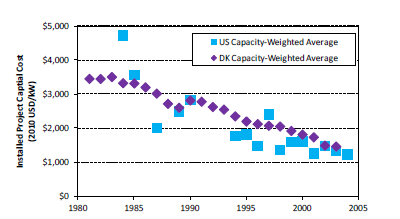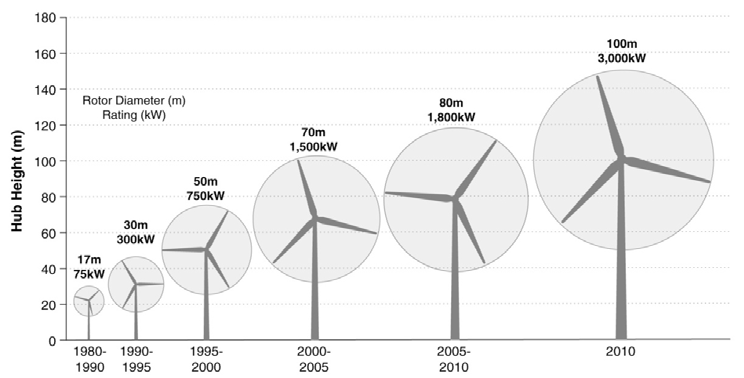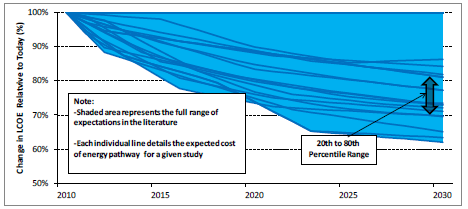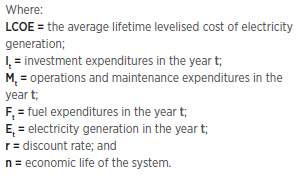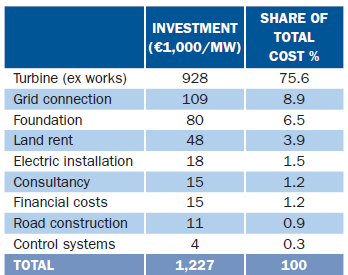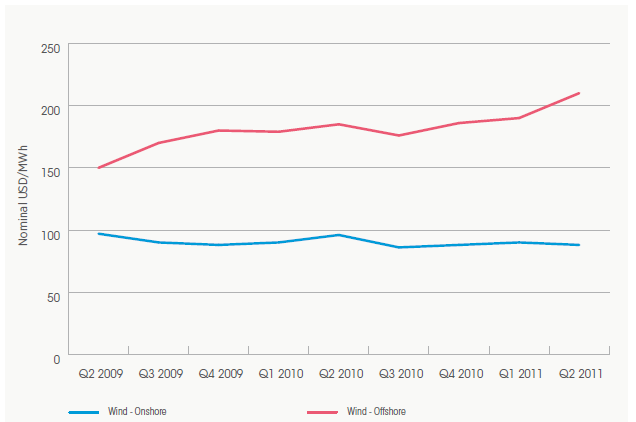Mechanical Engineering Wind Energy Scheme, GCSE Coursework Example
Abstract
Generating renewable power represents an industrial development resource that can help many countries establish sustainable access to reliable, secure, and clean energy. Renewable energy is a topic of much debate and its popularity in recent years has resulted in expansion in power generation capacity across the globe. It’s noted that, “tens of gigawatts of wind, hydropower and solar photovoltaic capacity are installed worldwide every year in a renewable energy market that is worth more than a hundred billion USD annually” [1]. The following research provides a scheme for wind energy that can most effectively capitalize off this market going forward.
Introduction to Wind Energy
The chosen alternative energy scheme for this project is wind energy and this is due to a range of factors. For starters, wind energy serves as a clean alternative to fossil fuels as a fuel source. This is due to the fact that wind does not distribute pollution to the air like power plants do, since wind turbines do not rely on the combustion of fossil fuels to function. Win energy also does not produce atmospheric emissions that potentially produce acid rain, or greenhouse gases. Another advantage is that is extracted from domestic regions to supply those specific regions with energy. The United States, over the past 10 years, has experienced an abundant amount of wind energy; it’s estimated that the average wind capacity has increased by 30% each year since 2005 [2]. It’s recommended that the selected wind energy scheme be a large turbine size project with a capacity of 1MW to 2.5MW. This could result in a capital cost of $3.8 million to $5 million dollars, but could pay itself off in less than five years. It also must be taken into account that the LCOE of longshore wind are expected to fall 20%-30% over the course of the next decade [4].
Problem Definition
Fuel price volatility has a significantly negative impact on the stability of the economy. One of the most important economic benefits to wind energy is that it reduces the economy’s exposure to fuel price volatility. This is a sizeable benefit and it’s great enough to justify a significant portion of geographic landscape across countries being utilized specifically for the purpose of wind energy generation. This benefit would still reign true even if wind energy were more expensive per kWh. The problem that arises when calculating the efficacy of wind energy as a plausible resource, specifically in regards to calculating cost “risk reduction from wind energy is presently not accounted for by standard methods for calculating the cost of energy, which have been used by public authorities for more than a century” [2]. One might think that the benefits of utilizing wind energy, specifically in regards to its ability to reduce pollution risks, as well as it’s clear affordability would promote engineers and developers to shift gears towards a wind energy based system, but as Krohn et al. (2009) notes, this is “quite the contrary, current calculation methods blatantly favor the use of high-risk options for power generation. In a situation where the industrialized world is becoming ever more dependent on importing fuel from politically unstable areas at unpredictable and higher prices, this aspect merits immediate attention” [2]. Despite the data revealing wind energy production to be a much more plausible and cost efficient method than traditional fuel based power generation, public policy across the globe has been apprehensive about adopting wind energy schemes. This is a challenge that can only be overcome through sound methods of production.
One of the primary methods within this project is to utilize LCOE trends and base the direction of the project on those trends. It should be noted that the primary directive of the project is constantly make sure LCOE trends are closely analyzed, with insights acquired through bottom up evaluation of historical cost drives in combination with advanced learning curve analysis. Other factors that place pressure on wind energy costs must also be taken into account. For example, movement or expansion to lower wind speed locations and the subsequent transmission needs are going to be issues that might arise with each project scheme. These are the types of factors that make utilizing the LCOE standard a critical aspect of structuring and effective wind turbine scheme as it integrates capital cost and performance factors together to assess potential future costs.
Review of existing schemes
The effectiveness of alternative energy schemes are primarily based on LCOE, otherwise known as levelized cost of energy. This is the main metric used by the utility industry to identify the cost of energy production. All energy schemes utilize LCOE to measure the sustainability of their projects and systems. It is assessed through calculating the expected lifetime costs of the scheme, like financing, construction, insurance, fuel, maintenance, taxes, and incentives, and then dividing them by the expected power output (kWh) over the lifetime of the scheme. Based on potential inflation, the calculations are adjusted for inflation and then discounted based on money’s value over time. LCOE is considerably valuable in respect to providing much needed information about effective energy generation schemes. For the purpose of analyzing schemes and proposing one within this research, LCOE will be utilized. Essentially LCOE is a financial tool, where a low LCOE signifies the cost of a particular method of energy production is low. Low LCOE also signifies that there is a potential high rate of return for investors utilizing the chosen method. If the cost for a renewable energy scheme like the use of wind turbines is as low as current traditional costs, it signifies that the method has reached “Grid Parity“. The formal definition of Grid parity, otherwise referred to as “socket parity,” is the point at which an alternative energy source generates power at an LCOE less than or equal to the cost of electric grid production. LCOE Estimates for renewable energy must take into account the impact of inflation on plant operations. This has an effect on how daily operations can be valued for the future as it entails maintenance costs and potentially assess the cost of the commodity feeding the power generation method. As authors notes, “As those costs rise, they are passed on to the ratepayer. A renewable energy plant is initially more expensive to build, but has very low maintenance costs, and no fuel cost, over its 20-30 year life” [7]. The ideal energy wind energy scheme will incorporate the most advanced technology in regards to components like project level design, affordable tools, turbines as well as insightful information related to tool costs. These efforts combined with an effective R&D system that can expand market knowledge on the industry and the project would make this project highly executable.
Wind energy projects had a decline in estimated average capital cost from 1980s through the early 2000s. Authors note that, “in the United States, capital costs were at their lowest level from roughly 2001 to 2004, approximately 65% below costs from the early 1980s” [1]. It’s further noted that the capital cost for wind energy projects in Denmark had a similar trend. The authors state that, “in Denmark, wind energy project capital costs declined 55% lower in 2003 than the rates revealed in the 1980s” [1]. This data can be seen depicted in Figure 1.
U.S. and Denmark capital cost trends from 1980 to 2003
Fig.1 [3]
Another factor that must be taken into account is the historical capital cost reductions combined with expansions in significant advancements in turbine performance due to innovative technology. This combination results in much larger turbines, which much greater capacity for a reduced cost of development and operation compared to those in previous years. For this specific wind energy scheme, it also must be taken into account that the LCOE of longshore wind are expected to fall 20%-30% over the course of the next decade [4]. One of the primary methods within this project is to utilize LCOE trends and base the direction of the project on those trends. Figure 2 illustrates how turbines have grown architecturally, as well as in rotor diameter, and capacity over the past 30 years.
Wind Turbine Architecture over the Past 30 Years
Fig2: [3]
It is important to note that the above illustration is an illustrated example of how falling costs and enhanced performance reshape a renewable energy scheme by reducing the LCOE. This is specifically what resulted in wind energy LCOE declining between 1980 and 2000s. The fact that the LCOE sharply declines demonstrates that there is still room for growth and innovation within the wind energy market due to a lack of knowledge, and this factor must be taken into account when calculating and effective budget for the wind scheme.
Proposed Scheme
The ideal energy scheme, to implement in order to fully utilize the power of wind energy, while balancing the cost and outperforming the fuel market is one that can incorporate grant programs for funding and these are largely based on the capacity of the project. It’s recommended that the selected wind energy scheme be a large turbine size project with a capacity of 1MW to 2.5MW. This could result in a capital cost of $3.8 million to $5 million dollars, but could pay itself off in less than five years.
Estimated Future Wind LCOE
Fig2: [3]
It is estimated that wind energy scheme LCOE will have a 40% reduction by 2030. This is largely due to the fact that, as time goes by, gas prices continue to increase; subsequently the cost of wind energy production and turbine costs fall further as the market expands. It can be expected that wind energy will eventually compete with gas fired power generation, but when comparing the cost of wind energy generation scheme with other methods of energy production, it is essential that the cost of turbine and grind development be taken into account.
Funding the Scheme
Projects with a capacity over 5MW are too large to utilize grants like the Feed-in Tariffs offered by governments seeking to supplement alternative energy production. Large wind projects are eligible for a Renewables Obligation Certificate (ROC). This method of funding is based on every MWh of electricity. ROCs are offered and distributed by Ofgem. They base their decision to award funding on monthly generation output data, which is submitted to the company showing two months’ worth of energy output. Based on this data proving the size and capacity of the system, Ofgem can identify where a project deserves funding within a month of the application being submitted. Authors note that, “ROCs can be sold, and have had a market value of around £45 per ROC since their introduction in 2002” [4]. The primary factor this reveals is that those seeking to enter the wind energy market have a financial incentive to build a larger grid.
This essentially means that financial incentives must be taken into account when calculating the budget. Similarly it also means that they can’t be calculated in regards to the long-term LCOE, due to the fact that each incentive is based on governmental policy. There are other calculations within the funding scheme of utilizing Feed-in Tarrifs or ROCs, such as the savings that can be earned with a Carbon Reduction Commitment (CRC) tax break. This is a common tax break applied to alternative energy companies, or energy companies in general in the United States, Europe, China and India. In regards to how CRC would work for this wind turbine scheme, authors note that, “under the current introductory phase CRC allowances cost $18 per ton CO2 emitted. Someone with a turbine of up to 5MW would receive a payment of at least $156 from the Feed-in Tariffs for generating enough electricity to save a ton of CO2” [4]. In this way there are more options for developers who might be considering developing a turbine with a capacity greater than 3MW, 4MW, or 5MW. Through government policies, and subsequent bonuses the time frame in which larger scale projects can pay themselves off is significantly reduced. Its further noted that, “a turbine owner of capacity greater than or equal to 5MW could sell the ROCs from generating the same amount of electricity for around $122. Claiming the Feed-in Tariffs or ROCs would therefore make more financial sense than saving money on the CRC allowances” [4]. Based on this data, the funding scheme this project would utilize to fund development is similar to a CRC allowance from the government depending on the region in which the turbines are being established.
Calculations
It’s recommended that the selected wind energy scheme be a large turbine size project with a capacity of 1MW to 2.5MW. This could result in a capital cost of $3.8 million to $5 million dollars, but could pay itself off in less than five years. When breaking down the costs related to wind turbine energy production and development of the system as an energy scheme, about 75% of the costs are upfront costs. This entails the cost of the establishing the foundation, the cost of setting up the turbines, the cost of purchasing and establishing the grid connection, and the cost of miscellaneous electrical equipment. All calculations are done using the LCOE equation.
LCOE Equation
Fig3: [1]
The above equation is broken down into factors that equate to the LCOE, which is the average lifetime levelised cost of electricity generation. The value “I” represents the investment expenditures and that is based on the given year and that is calculated with the value t. The value M represents the maintenance and operations expenditure which is also measured by the value t. The value F is representative of the fuel expenditures. The value E stand for electric generations produced by the energy method. The value r represent the rate, and the value n represent the economic life of the system.
One noticeable advantage wind energy production costs have compared to traditional fuel based methods is that fluctuations in fuel prices have no impact on the cost of the wind turbine scheme. This allows wind energy schemes to be capital intensive. For the purpose of this scheme 2 MW wind turbines will be utilized and the breakdown of the budget for this scheme per turbine can be seen below. This means the wind turbine method as a whole is capital-intensive compared to conventional fossil fuel fi red technologies such as a natural gas power plant, where as much as 40-70% of costs are related to fuel and O&M.
Wind Turbine Price Structure
Fig4: [5]
The above table demonstrates that there are no variable costs associated with wind turbine energy grids. In fact, as the system is not reliant on fossil fuels at all making the overall cost more controllable and easier to calculate over a set period of time. This in turn carries over to investors who may be looking to identify a more stable market of investment. This allows business developers seeking to incorporate wind energy as a method for sustain production.
The Average Cost of Producing Wind Energy Based on Capacity of Project
| Turbine size | Capital cost per turbine | Feed-in-Tariff generation rate (current, £/kWh) | Simple payback period |
| Building-mounted micro (2.5kW) | £10,000 | £0.27 | May not payback within lifetime |
| Micro (6kW) | £20 – £28,000 | £0.27 | May not payback within lifetime |
| Small (20 – 50kW) | £50,000 – £125,000 | £0.24 | 8 – 15 years |
| Medium (100kW – 850kW) | £250,000 to £1.8 million | £0.09 – £0.19 | 7 – 9 years |
| Large (1MW – 2.5MW) | £2 million – £3.3 million | £0.05 – £0.09 | less than 1 year – 5 years |
Fig5:[6]
The median cost of producing electricity by utilizing substantial onshore wind is an estimated 3 to 4 pence per kilowatt hour, which has it slightly competing with new coal costing an estimated 2.5 – 4.5 pence. Both new coal and wind power cost less than new nuclear, which costs an estimated 4 – 7 pence per hour. Ten pence is the equivalent of 15 cents USD. One significant problem that wind turbines can assist with is the rising cost of fuel prices. Businesses, or communities reliant on fossil fuels as a power source, now have a distinct alternative they can utilize which is much more affordable. For the purpose of this scheme, the project can be most cost effective by incorporating government subsidies that might alleviate some of the growing pains associated with starting small and working up to a larger scale.
Wind power projected costs for project schemes developed between 2011 and 2015, have a wide range of shifts in wind capacity. This is largely due to fluctuations in wind quality and the capacity of feature functions to utilize wind as a resource. Often capacity is influenced by wind turbines varies significantly depending on whether the turbines are placed onshore or offshore. This is a factor that must be taken into account when calculating.
Wind Power LCOE Capacity Trends Onshore Verses Offshore
Fig6: [1]
The LCOE for onshore wind is presented in Figure 6 demonstrates that the actual placement of the turbines substantially impacts the capacity levels that are utilized. Authors note that, “in China and India installed costs for onshore wind farms as low as one half that of the level seen in developing countries in 2010 and 2011” [1]. This explains why the LCOE of wind in these regions are significantly lower than in North America or Europe depending on the given capacity that is assessed. It’s further noted that, “in India in 2010, the average capacity factor for data from four states with around four-fifths of total capacity in India was 20%, but there has been a trend towards higher capacity factors over time” [1]. The rend for higher capacity factors is something that is proven time and time again worldwide, which makes it an essential aspect of calculating data.
Total Installation costs for Wind Farms onshore in India/China, North America and Europe 2010, 2011, and 2015.
Fig6: [1]
The difference in LCOE of onshore wind for Europe and North America is virtually identical. The only real difference between the two is that Europe’s capital costs for projects are slightly lower. The United States offsets this by having lower operational maintenance costs (O&M). It’s further noted that, “the very low capital costs of projects in China and India mean that, for a given capacity factor, the LCOE of wind is 31% to 45% lower than in North America and 36% to 46% lower than in Europe. The estimated LCOE of wind for Europe in 2011 was between USD 0.10 and USD 0.13/kWh” [1]. These numbers are based on the fact that typical loads in Europe in respect onshore projects had a range from 25 to 30 percent [1]. It can be assumed that there will be a reduction in LCOE in 2015 of about 6% or 7% depending on the given capacity of wind projects. Throughout the U.S. and other parts of North America, when a capacity factor of 30 percent is assumed, the range for 2011, “was between USD 0.10 and USD 0.11/kWh” [1]. It’s further noted that, ”using this range implies the LCOE for wind in North America ranged from as low as USD 0.07/kWh to a high of as much as USD 0.16/kWh. By 2015, cost reductions could reduce the LCOE of wind in North America by 5% to 9% for a given capacity factor” [1]. This requires developers and mechanics when assessing the potential cost of a wind scheme project to take into account weighted average capacity factors when trying to evaluate how efficient a project can be at producing energy. For example, it’s noted that in 2015, “the weighted average capacity factor could increase from 30% to 35%” [1]. If this were to happen it would result in a LCOE reduction for wind energy in North America that could range between 0.08 USD to 0.09USD per kilowatt hour /kWh. When the average value of 2011 is applied to this equation, the LCOE comes out to be 18 percent to 20 percent. This demonstrates that there is a dramatic reduction in LCOE of wind energy production happening due largely in part to increased capacity, which is why it recommended that the selected wind energy scheme be a large turbine size project with a capacity of 1MW to 2.5MW. This could result in a capital cost of $3.8 million to $5 million dollars, but could pay itself off in less than five years. It also must be taken into account that the LCOE of longshore wind are expected to fall 20%-30% over the course of the next decade [4].
Conclusion
In sum, the cost of wind energy projects have dramatically decreased over the past thirty years. This is in part attributed to performance improvements, while also the impact capital cost reductions have on the windmill production process. Despite this trend between 2004 and 2009, increased performance was not a substantial enough factor to offset capital cost increases. This in turn resulted in wind energy production having an overall increase in the cost of development and operations. Since then, capital costs have fluctuated and declined resulting in the cost of wind energy having historical lows since 2010. Going forward, data suggests that wind energy production LCOE will continue to decline making wind energy a much more affordable option in comparison with other methods. This is also believed to occur on a long term global basis. The ideal energy scheme, to implement in order to fully utilize the power of wind energy, while balancing the cost and outperforming the fuel market is one that can incorporate grant programs for funding and these are largely based on the capacity of the project. It’s recommended that the selected wind energy scheme be a large turbine size project with a capacity of 1MW to 2.5MW. This could result in a capital cost of $3.8 million to $5 million dollars, but could pay itself off in less than five years. It also must be taken into account that the LCOE of longshore wind are expected to fall 20%-30% over the course of the next decade [4]. One of the primary methods within this project is to utilize LCOE trends and base the direction of the project on those trends. It should be noted that the primary directive of the project is constantly make sure LCOE trends are closely analyzed, with insights acquired through bottom up evaluation of historical cost drives in combination with advanced learning curve analysis. Other factors that place pressure on wind energy costs must also be taken into account. For example, movement or expansion to lower wind speed locations and the subsequent transmission needs are going to be issues that might arise with each project scheme. These are the types of factors that make utilizing the LCOE standard a critical aspect of structuring and effective wind turbine scheme as it integrates capital cost and performance factors together to assess potential future costs. Utilizing LCOE enables engineers and mechanics to predict the responding to changes in quality of wind sources, development costs and transmission. There are also needs to be continuous collection of robust data as this is still a developing market that requires much more understanding of how these factors are influencing the cost and development of wind energy projects. Data that can allows engineers to understand the overall development speed of one of these projects and the difference in the cost of development, in a short isolated period, to the cost of operation over an extended period of time, while not overlooking the cost of maintenance and how inflation and capital cost impact all three.
References
Gielen, D., IRENA Secretariat, “Renewable Energy Technologies: Cost Analysis Series. Wind Power” International Renewable Energy Agency. 2012, pp.1-64.
Krohn, S., Morthorst, P. E., & Awerbuch, S. “The Economics of Wind Energy.” European Wind Energy Association, 2009, pp.1-156.
Lantz, Eric, Ryan Wiser, and Maureen Hand. “The past and future cost of wind energy.” National Renewable Energy Laboratory, Golden, CO, Report No. NREL/TP-6A20-53510 (2012).
Local Government House. “How Much do Wind Turbines Cost and Where Can I get Funding?” Local Government Association. 2015
Wiser, R.; Bolinger, M. (2011). 2010 Wind Technologies Market Report. DOE/GO-102011-3322. Washington, DC: U.S. Department of Energy Office of Energy Efficiency and Renewable Energy
Nielsen, P.; Lemming, J.; Morthorst, P.E.; Clausen, N.E.; Lawetz, H.; Lindboe, H.H.; James-Smith, E.; Bang, N.C.; Strøm, S.; Larsen, J. (2010). Vindmøllers Økonomi (The Economy of Wind Power). EUDP 33033-0196. Prepared by EMD International, Aalborg, Denmark.
Renewable Energy Advisors. “What is LCOE” Renewable Energy Advisors. 2015.

Time is precious
don’t waste it!

Plagiarism-free
guarantee

Privacy
guarantee

Secure
checkout

Money back
guarantee



